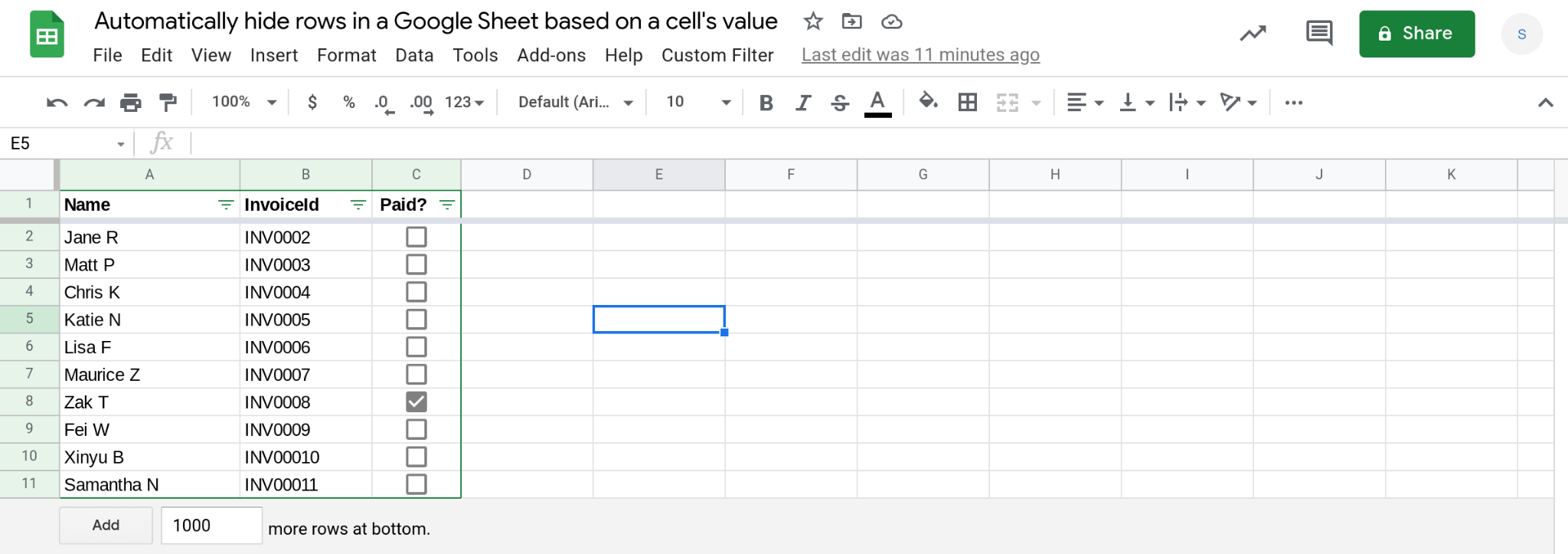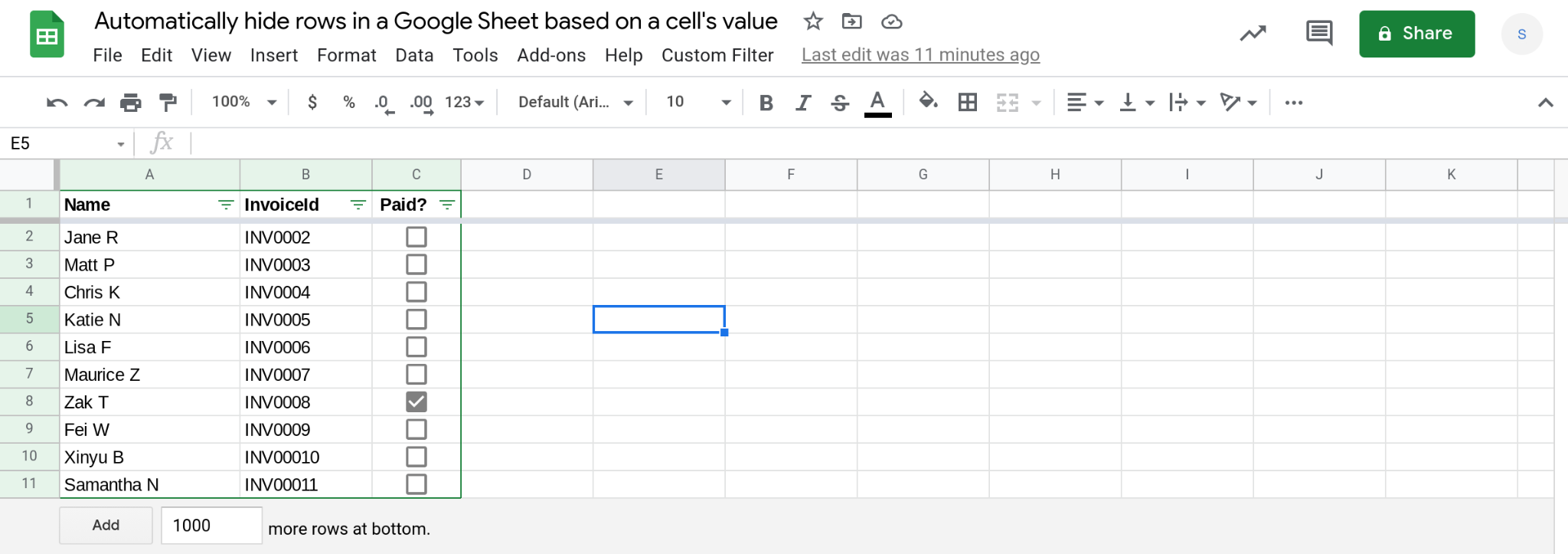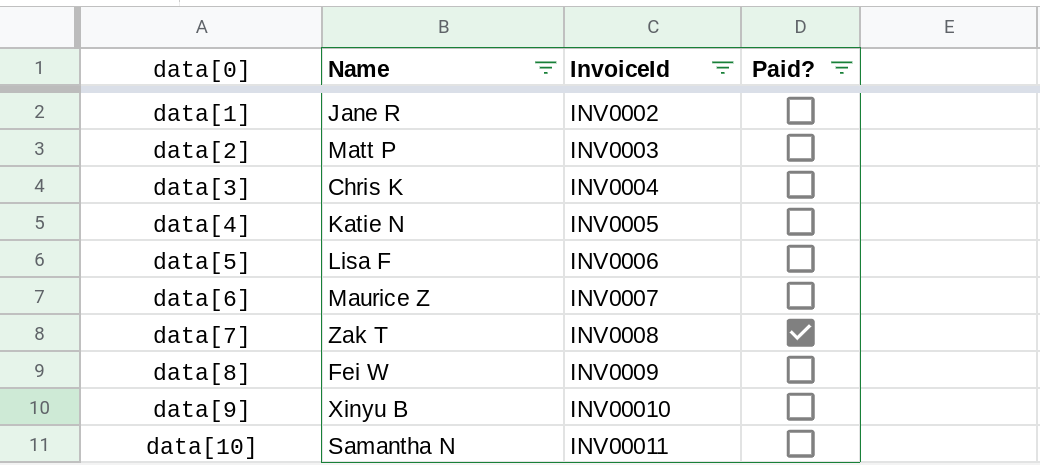Hide rows based on cell value in Google Sheets using Apps Script
In this tutorial I will show you how to hide rows in Google Sheets based on cell value. In the spreadsheet below, there are three columns: Name, InvoiceId and Paid. The column Paid can contain either "Y" or "N" and we've inserted checkboxes with custom values to make it easy to set the payment status of each invoice. Our objective is to make it easy to hide invoices that have already been paid. That is, we want to hide rows where the checkbox is checked.
Note
If you do not know how to use checkboxes or if you do not want to use them, you can simply enter Y or N in each row for payment status. The checkbox is effectively doing the same thing behind the scenes.
If you do use checkboxes and you forget to specify custom values, please note that by default, checkboxes have TRUE and FALSE values associated with their checked and unchecked states respectively.

There are a few different ways to achieve this. For e.g., you can create a filter or a filter view in your sheet. However, the disadvantage of these methods is that it can be cumbersome to hide or unhide rows as you make changes to your sheet. The video below demonstrates this.
In the video above, despite setting up a filter, it isn't easy to hide rows that are newly marked as paid. You have to select the filter settings and then select Ok each time you want the filter to process new changes in your spreadsheet.
In this tutorial, I will show you how to make this workflow more seamless by using Apps Script. We will build a custom menu called "Custom Filter" with two menu items: (1) Filter rows, and (2) Show all rows. Selecting Filter rows will hide all rows that are marked as paid. Selecting Show all rows will unhide all rows in your spreadsheet. The video below demonstrates this.
Prerequisites
This tutorial assumes that you're familiar with the following concepts:
Basics of working with Google Sheets
Note: If you've never programmed using Apps Script before, I've written a series of tutorials to help you learn the basic concepts.
4 steps to hide rows based on cell value in Google Sheets using Apps ScriptStep 2 — Create a function to filter rows based on the value in a specific column
Step 4 — Create a custom menu to make it easy for users to run these functions
Step 1 — Create your Google Sheets spreadsheet
Step 2 — Create a function to filter rows based on the value in a specific column
Step 4 — Create a custom menu to make it easy for users to run these functions
The first step is to open your spreadsheet or create a new one. I'm using a spreadsheet with 3 columns: Name, InvoiceId and Payment status (Paid?).

Our goal is to hide rows where the cell in a given column has a specific value. In this tutorial, we will hide rows where the payment status is set to "Y" (i.e., the checkbox is checked).
Once you have your spreadsheet ready, the next step is to write some code using Apps Script. Open the Apps Script code editor by selecting Extensions —> Apps Script and then proceed to Step 2.
Step 2 — Create a function to filter rows based on the value in a specific column
Create a function called filterRows() that will hide rows in your sheet where the 3rd column (the payment status column) has the value Y.
Note
Even though the sheet uses checkboxes for recording payment status, the value in each cell of that column (with the exception of the header row) is either Y or N based on whether the checkbox is checked or not.
function filterRows() {
var sheet = SpreadsheetApp.getActive().getSheetByName("Data");
var data = sheet.getDataRange().getValues();
for(var i = 1; i < data.length; i++) {
//If column C (3rd column) is "Y" then hide the row.
if(data[i][2] === "Y") {
sheet.hideRows(i + 1);
}
}
}How does the filterRows() function work?
The function first gets a reference to the sheet named Data.
var sheet = SpreadsheetApp.getActive().getSheetByName("Data");Next it gets all the values from that sheet. These values are structured as a two-dimensional array. If you're not familiar with how this works, please refer to the tutorial on reading all the data from a sheet in a Google Sheets spreadsheet.
var data = sheet.getDataRange().getValues();Then, a for loop is used to iterate through elements in the outer array. Each element in this outer array is a row in your sheet. Therefore, each element in this outer array is itself an array of values in that row.
for(var i = 1; i < data.length; i++) {
//If column C (3rd column) is "Y" then hide the row.
if(data[i][2] === "Y") {
sheet.hideRows(i + 1);
}
}In the loop above, the variable i is set to 1 initially (usually it is set to 0 when iterating through arrays). This is because the first element in the two-dimensional array is the header row and we would never want to hide it. We use an if statement to check if the value in the 3rd column of each row is the value "Y". If it is, we hide the corresponding row. Please note that row numbers start from 1 and not 0. So, the header row is row number 1. However, the array indices start at 0. So, the first element of the array data (i.e., the header row) is at position 0 and not 1. This is why we hide the row i+1 and not i. The screenshot below shows this. The value data[0] represents row 1 and this is the header row. Therefore, if we want to hide the row corresponding to data[9], we should hide row 10.

If you are using your own spreadsheet as you follow along this tutorial, remember to edit the highlighted parts below based on your use case.
if(data[i][2] === "Y") {
sheet.hideRows(i + 1);
}
Replace 2 with the index of the column that should be checked. If column N should be checked then the index is N-1. In this tutorial, we are checking the 3rd column (the payment status column) so we are using the index 2.
Replace "Y" with the value that will cause that row to become hidden. In this tutorial, we want to hide all rows that have payment status set to "Y". Your use case might be different.
Step 3 — Create a function to show all rows
Create a function called showAllRows() that will unhide all the rows in your sheet.
function showAllRows() {
var sheet = SpreadsheetApp.getActive().getSheetByName("Data");
sheet.showRows(1, sheet.getMaxRows());
}How does the showAllRows() function work?
The function first gets a reference to the sheet named Data.
var sheet = SpreadsheetApp.getActive().getSheetByName("Data");Then it unhides all rows using the showRows() method. The showRows() method accepts two row numbers as parameters. The rows in between these two rows will be unhidden. Since we want all the rows to be shown, we specify 1 and sheet.getMaxRows() as the two row numbers.
sheet.showRows(1, sheet.getMaxRows());Step 4 — Create a custom menu to make it easy for users to run these functions
The final step is to create a custom menu to make it easy for you (and other users) to run the two functions. We create two menu items in the menu, one to filter rows and another to show all rows. If you're not familiar with custom menus, please refer to the tutorial on custom menus in Google Sheets.
function onOpen() {
SpreadsheetApp.getUi().createMenu("Custom Filter")
.addItem("Filter rows", "filterRows")
.addItem("Show all rows", "showAllRows")
.addToUi();
}Full code
For your convenience, I've pasted the full code below.
Note
The comment @OnlyCurrentDoc at the top tells Apps Script that it should only get permissions to the spreadsheet corresponding to this script. That is, your script shouldn't be able to access other files in Google Drive or other Google services that require permission.
//@OnlyCurrentDoc
function onOpen() {
SpreadsheetApp.getUi().createMenu("Custom Filter")
.addItem("Filter rows", "filterRows")
.addItem("Show all rows", "showAllRows")
.addToUi();
}
function filterRows() {
var sheet = SpreadsheetApp.getActive().getSheetByName("Data");
var data = sheet.getDataRange().getValues();
for(var i = 1; i < data.length; i++) {
//If column C (3rd column) is "Y" then hide the row.
if(data[i][2] === "Y") {
sheet.hideRows(i + 1);
}
}
}
function showAllRows() {
var sheet = SpreadsheetApp.getActive().getSheetByName("Data");
sheet.showRows(1, sheet.getMaxRows());
}How to use
After entering the code in the Apps Script editor, here's how to use the custom menu:
Save your script by clicking the floppy disk icon or using the keyboard shortcut Ctrl+S (Cmd+S on Mac).
Close the Script editor and return to your Google Sheet. You may need to refresh the page to see the changes.
You should now see a new menu item called "Custom Filter" in your Google Sheets menu bar.
To hide rows where the payment status is "Y", click on "Custom Filter" > "Filter rows".
To show all rows again, click on "Custom Filter" > "Show all rows".
That's it! You can now easily filter and unfilter your rows based on the payment status using the custom menu.
Conclusion
In this tutorial I showed you how to hide rows based on cell value in Google Sheets.
I hope you found this tutorial helpful. Thanks for reading!
How was this tutorial?
Your feedback helps me create better content
DISCLAIMER: This content is provided for educational purposes only. All code, templates, and information should be thoroughly reviewed and tested before use. Use at your own risk. Full Terms of Service apply.
Small Scripts, Big Impact
Join 1,500+ professionals who are supercharging their productivity with Google Sheets™ automation
By subscribing, you agree to our Privacy Policy and Terms of Service

